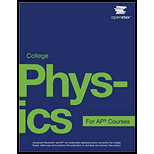
Concept explainers
Volcanic and other such activity at the mid-Athletic ridge extrudes material to fill the gap between separating tectonic plates associated with continental drift. The magnetization of rocks is found to reverse in a coordinated manner with distance from the ridge. What does this imply about the Earth's magnetic field and how could the knowledge of the spreading rate he used to give its historical record?
What does this imply about the Earth's magnetic field?
Answer to Problem 1CQ
It implies that there is no magnetic force at the center of the earth where molten metal is present, and also suggest that there is a strong magnetic field outside the earth under the influence of which the earth gets magnetize.
Explanation of Solution
When the molten lava comes out form the volcano, it gets solidifies into a rock and it get magnetize in the direction of the local magnetic field, and at the center of the lava there is no magnetic field.
Similarly, it indicates that when the earth is in molten state there is no magnetic field, but as it starts cooling the outer layer of the earth gets magnetize under the influence of strong magnetic field. It also implies that there is a strong magnetic field outside the earth due to which the earth gets magnetize at the North and the South Pole.
Conclusion:
It implies that there is no magnetic force at the center of the earth where molten metal is present, and also suggest that there is a strong magnetic field outside the earth under the influence of which the earth gets magnetize.
Want to see more full solutions like this?
Chapter 22 Solutions
College Physics For Ap® Courses
Additional Science Textbook Solutions
Microbiology: An Introduction
Campbell Biology: Concepts & Connections (9th Edition)
Genetic Analysis: An Integrated Approach (3rd Edition)
Human Physiology: An Integrated Approach (8th Edition)
Physics for Scientists and Engineers: A Strategic Approach, Vol. 1 (Chs 1-21) (4th Edition)
Campbell Essential Biology (7th Edition)
- Is work function of a metals surface related to surface energy and surface tension? What is the need to the work function component in the math of tension of metal surfaces that cannot be provided by existing equations of surface energy and surface tension? What are the key differences in each parameter and variables that allow for a differentiation of each function? What has a more significant meaning work function, surface tension or surface energy? Are there real differences and meaning? Please clarify and if possible provide examples . Does surface tension dependant on thickness of a metal or type of metal surface all having the same thickness? Clearly temperature has a profound change on surface tension what other variables besides temperature are key to surface tension. What if any is there a connection between crystal structure of the element and surface energy and tension? This is NOT a Assignment Question!!!arrow_forwardThe cylindrical beam of a 12.7-mW laser is 0.920 cm in diameter. What is the rms value of the electric field? V/marrow_forwardConsider a rubber rod that has been rubbed with fur to give the rod a net negative charge, and a glass rod that has been rubbed with silk to give it a net positive charge. After being charged by contact by the fur and silk...? a. Both rods have less mass b. the rubber rod has more mass and the glass rod has less mass c. both rods have more mass d. the masses of both rods are unchanged e. the rubber rod has less mass and the glass rod has mroe massarrow_forward

 College PhysicsPhysicsISBN:9781938168000Author:Paul Peter Urone, Roger HinrichsPublisher:OpenStax College
College PhysicsPhysicsISBN:9781938168000Author:Paul Peter Urone, Roger HinrichsPublisher:OpenStax College Physics for Scientists and Engineers: Foundations...PhysicsISBN:9781133939146Author:Katz, Debora M.Publisher:Cengage Learning
Physics for Scientists and Engineers: Foundations...PhysicsISBN:9781133939146Author:Katz, Debora M.Publisher:Cengage Learning
 Glencoe Physics: Principles and Problems, Student...PhysicsISBN:9780078807213Author:Paul W. ZitzewitzPublisher:Glencoe/McGraw-Hill
Glencoe Physics: Principles and Problems, Student...PhysicsISBN:9780078807213Author:Paul W. ZitzewitzPublisher:Glencoe/McGraw-Hill Principles of Physics: A Calculus-Based TextPhysicsISBN:9781133104261Author:Raymond A. Serway, John W. JewettPublisher:Cengage Learning
Principles of Physics: A Calculus-Based TextPhysicsISBN:9781133104261Author:Raymond A. Serway, John W. JewettPublisher:Cengage Learning





